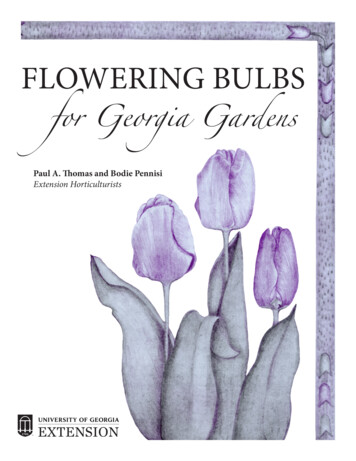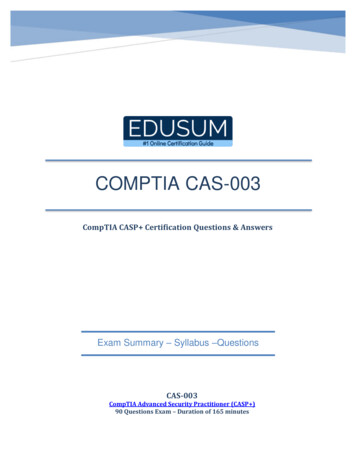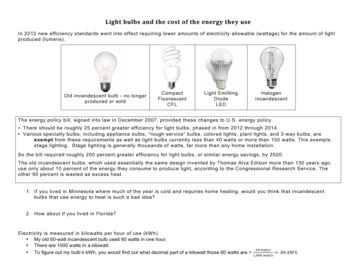
Transcription
FLOWERING BULBSfor Georgia GardensPaul A. Thomas and Bodie PennisiExtension Horticulturists
AMost are grown for their flowers and some forA rhizome is a specialized stem structure in which themain stem of the plant grows horizontally at or justbelow the soil surface. Examples include iris, canna,and lily-of-the-valley. Rhizomes bear the same internal and external structure as true stems.wide variety of bulbs grow well in Georgia.their foliage. They are grown as pot plants, in shrubborders, naturalistic plantings and in mass displays.Bulbs offer a certain magic to the landscape virtuallyunrivaled by other plants.TerminologyWhat Is a Bulb?Bulbs are often categorized according to their hardiness, time of bloom and size.The term “bulb” is used in this publication to referto true bulbs and other bulb-like structures such ascorms, tubers, rhizomes and tuberous roots and stems(Figure 1). The primary function of these modifiedplant parts is food storage to ensure the plant’s survival during adverse weather conditions. Distinguishing among these structures is important, since each ishandled differently with respect to culture, propagation and care.Under normal conditions, hardy bulbs are those thatsurvive cold climates. Semi-hardy bulbs are thosethat are hardy in milder climates but not reliable incolder climates without protection. Tender bulbs donot tolerate freezing and can be left in the groundonly in warm climates. Georgia has three districtUSDA hardiness zones (Figure 2). Your location willdetermine which bulbs are hardy in your given areaand will influence time of bloom. Bulbs will flowertwo or more weeks earlier in Zone 9 than in Zone 7.A bulb is a specialized underground organ consisting of a short, fleshy, usually vertical stem axis (basalplate) bearing at the top a growing point or a flowerbud enclosed by thick, fleshy scales. There are twotypes of bulbs: the tunicate or laminate type represented by the daffodil and tulip, and the non-tunicateor scaly type represented by the lily. Small bulbscalled bulblets form at the base of the mother bulb and,with some lilies, along the underground stem. Someplants also produce aerial bulbs called bulbils.Spring-flowering bulbs consist largely of the so-calledDutch bulbs. Planted in the fall, they bloom the following spring; most spring-flowering bulbs are completely hardy in Georgia. Summer-flowering bulbsinclude hardy to tender bulbs that flower in summer;some summer-flowering bulbs continue to floweruntil frost. Fall-flowering bulbs, consisting largely ofa few hardy bulbs, flower in late summer or early fall.The term winter-flowering generally refers to tenderbulbs simply forced to bloom out-of-season indoors.A few bulbs bloom outdoors in very early spring andare sometimes called winter-flowering.A corm is the swollen base of a stem axis enclosed bydry, scale-like leaves. Examples include crocus andgladiolus. In contrast to a true bulb, a corm is a solidstem structure with distinct nodes and internodes.Small corms produced around the base of the oldcorm are called cormels.So-called minor bulbs are small in stature comparedto the larger, showier bulbs. They can be used to greatadvantage in the landscape. Many, such as crocus, areespecially valued because of their early floweringhabit.A tuber is a modified stem structure that developson underground stems. Examples include Irish potato and caladium. A few plants produce small aerialtubers known as tubercles.Site SelectionSome sources make a further distinction among tubers, referring to structures that arise primarily fromenlarged stem tissue as tuberous stems. These structures, in tuberous begonia and gloxinia, for example,develop at the soil surface.Most spring-flowering bulbs prefer light shade to fullsunshine. Try to select a site that provides at least 6 to10 hours of direct light per day. This need not restricttheir planting to areas that are in full sun year-round.Because many spring-flowering bulbs bloom and produce foliage well before most deciduous trees leaf out,they get plenty of sun under the canopy of such trees,which offer dense shade later in the season. Lightrequirements for other bulbs, especially the summerbulbs, are more variable. Select a spot where they willreceive the recommended amount of light. InsufficientCertain species of herbaceous perennials such assweet potato and dahlia produce thickened underground roots. These structures are called tuberousroots (fat roots or fleshy roots) and have the sameexternal and internal structure as normal roots.Flowering Bulbs for Georgia Gardens2UGA Cooperative Extension Bulletin 918
Figure 2. USDA plant hardiness zones for Georgia.heavy rain or dry out too quickly. Good drainage isessential. If in doubt, test for drainage before planting.Dig a hole about a foot deep and fill it with water. Thenext day fill the hole with water again and see howlong it remains. If the water drains away in 8 to 10hours, the soil is sufficiently well drained to growmost bulbs.If drainage is a problem or if the soil is too sandy or aheavy clay, you may need to use a soil amendment.Peat moss, bark, rotted sawdust, compost, perlite, vermiculite, coarse sand and many other materials havebeen used successfully. The type of amendment needed depends on the structure and texture of the existing soil, drainage and the type of bulbs to be grown.Spread several inches of material on the soil surfaceand thoroughly incorporate it. In extreme cases, youmay need to install drainage lines or construct raisedbeds to ensure good drainage.Figure 1. Specialized storage organs, often referred to asbulbs.light usually results in poor flowering, but too muchlight will bleach the flowers and foliage of some species.A pH of 6.0 to 6.8 is best for most bulbs. Incorporatelime if a soil test indicates a need for it. In the absenceof a soil test, add 1 to 2 pounds of 5-10-10, 10-10-10 or8-8-8 fertilizer per 100 square feet of bed space. Organic fertilizers such as bonemeal are often recommended for bulbs, but they are probably no betterthan inorganic sources used at the proper rates.Incorporate lime, fertilizer and any soil amendmentsthoroughly and deeply, to at least 12 inches. Do notattempt to work the soil when it is too wet. If youcan crumble the soil between your fingers, it is dryenough for digging and planting.Also consider locating beds and plants where theywill be aesthetically pleasing and effectively arrangedin the landscape.Bed PreparationThe majority of bulbous plants are actually less particular about soil than many other cultivated plants.Most, however, prefer a moist, well-drained mediumsandy loam that does not remain wet and sticky afterUGA Cooperative Extension Bulletin 9183Flowering Bulbs for Georgia Gardens
Bodie PennisiFigure 3.Selecting BulbsBulbs are sold in a variety of retail outlets. Alwaysbuy from a reputable dealer. Avoid bulbs that are softor look molded or discolored. Bulbs should be firmand have unblemished skin. There is a direct correlation between the quality of the bulb and the qualityof the flower produced; bargain bulbs are no bargain!Spring-flowering bulbs purchased in the spring aresimply leftovers from the previous fall and are virtually worthless.Figure 4.times the greatest diameter for bulbs 2 inches or morein diameter and three to four times the greatest diameter for smaller bulbs.Bulbs are generally graded and sold according to size,usually circumference. Large bulbs produce largerand/or multiple flowers. The largest bulbs are notnecessary for good landscape effect. In most cases,medium grades are entirely satisfactory.Spacing will vary from 1 to 2 inches to as much asseveral feet. When spacing bulbs, consider not onlyhow much space each plant needs, but also howfrequently it will be dug and divided. Also, considerthe landscape effect. Avoid spotty or line-out arrangements. It is sometimes suggested that bulbs be broadcast over the area to be planted in order to achieve anaturalistic look; this is unadvisable, however, because dropping or throwing the bulbs may bruise orinjure them.PlantingPlant spring-flowering bulbs in the fall. In Georgia,spring-flowering bulbs can be planted from Octoberthrough late December in most areas. If you cannotplant the bulbs right away, store them in a dry areaat around 60-65 F. Temperatures above 70 F maydamage the flower buds. In areas of the state withextremely mild winter climates, it may be desirableto pre-cool some bulbs. Most spring-flowering bulbsrequire a 12- to 16-week cold period in ventilatedpackages in the bottom of your refrigerator at 4050 F before planting. Check with your bulb supplierto determine whether the bulbs you purchased havebeen pre-cooled or whether you may need to givethem a cold treatment.Plant the bulbs upright (rhizomes and tuberous rootsare usually planted on their sides), and press the soilfirmly around them. Water the beds thoroughly tohelp settle the soil.Care and MaintenanceMulches or ground covers may be necessary to ensurewinter survival of some bulbs. They not only minimize winter injury, but also provide a backgroundagainst which little bulbs show to better advantage.Mulch also prevents mud-spattering from heavy rainsthat frequently spoil the flowers. Pine straw, bark, fallleaves and many other organic materials make satisfactory mulches for bulbs.Summer-flowering bulbs are planted in spring afterthe danger of frost has passed.Planting depth and spacing are very important to thesuccess of bulbs. A general rule of thumb for plantingdepth (from top of bulb to soil surface) is two to threeFlowering Bulbs for Georgia GardensMechanical protection may be required to preventwind damage. Wind breaks or staking may be nec4UGA Cooperative Extension Bulletin 918
Naturalizing Bulbsessary for tall plants like lilies. There is no effectivemeans of providing cold protection once the plant isin bloom. While late or severe cold waves occasionally spoil spring-flowering bulbs, the bulbs are amazingly resilient and many withstand severe cold.You can use several methods to naturalize bulbs inthe landscape. The first is to randomly scatter selfestablishing bulbs such as daffodil and crocus on theground before leaf drop in the fall. These bulbs willroot and establish themselves under the leaves byspring. Another method is simply to dig severalshallow pits in the soil under wooded areas and laythe bulbs right side up and replace the soil. The thirdmethod involves inserting crocus bulbs under thethatch of your lawn, so the crocus will fill your lawnwith color prior to the greening of the grass. Crocusfinish most of their food storage activities prior to thefirst mowing of the grass, so this combination worksout very well. However, application of herbicides canaffect crocus bulbs adversely, so consult your countyagent if you have any doubts. Naturalized bulbs allneed to be fertilized in the fall and just after floweringto maintain full vigor. In many areas of the country,failure to fertilize will result in gradually decliningbulb populations.A well-prepared bed should require little cultivationexcept periodic weeding. Many spring-floweringbulbs are “overplanted” with other plants, frequentlyannuals. Be sure not to dig so deeply as to damagethe bulbs. When the bulbs flower, fertilize them againusing the fertilizers and rates previously mentioned.When the flowers fade, cut them off to prevent seedformation. It is best not to cut or remove the foliageuntil it dies naturally. Most spring-flowering bulbsproduce foliage in fall or early spring that dies by latespring or early summer. Summer-flowering bulbs produce their foliage in spring; it usually remains untilcold weather kills it in the fall. Most of the fall-flowering bulbs produce foliage when the spring-floweringbulbs do; they simply flower at a different time.Normal rainfall usually provides enough moisture forspring-flowering bulbs but not for summer-floweringbulbs. During dry weather, provide supplementalirrigation at weekly intervals. Soak the ground thoroughly. Bulbs have a much higher water requirementwhen actively growing than when dormant.Forcing BulbsYou can force bulbs to bloom indoors earlier thanthey normally would outdoors. Crocus, galanthus,hyacinth, narcissus, daffodil, scilla and tulip are easierto force than most.Eventually, almost all bulbs become overcrowded andmust be divided and replanted for best effect. Thelength of time depends largely on the bulb’s ability toproduce bulblets. Some may remain undisturbed formany years while others may require dividing everytwo to three years. Do not dig bulbs until the foliagehas turned yellow and withered. Be cautious whendigging so as not to damage the bulbs.Pot the bulbs in October or November using a welldrained soil. The number of bulbs per pot will varyaccording to pot and bulb size. Keep them in darknessat about 40 F for 8 to 12 weeks in a cold frameoutdoors, in an unheated garage or basement, or inyour refrigerator. (The bulbs must not be allowed tofreeze.) Do not allow the soil in the pots to dry out.Bulbs and corms can be gently pulled apart. Tubersand rhizomes may be cut into pieces, each divisioncontaining at least one eye. Tuberous roots can be splitapart. Some tuberous roots, like dahlia, also requirethat a small piece of crown tissue remain attached.After 8 to 12 weeks, the root system should be extensively developed and the shoots emerging from thebulbs. Move the pots to a cool, well-lighted spot forcontinued growth. They will bloom in about onemonth. Avoid high temperatures and/or poor lightbecause they will cause stretching and weak stems.Wash off any soil that clings to the bulb. The bulbscan be replanted immediately or stored for later planting. Store in a dry place away from sunlight, preferably at 60-65 F. Be sure to provide good air circulation.Discard any bulbs that appear diseased.Crocus, hyacinth, narcissus and tulip bulbs can berefrigerated at 40 F for two months prior to planting,then potted and forced as above. The results are notusually as satisfactory since less time exists for theroot system to develop.Remember that tender bulbs will need to be dug inearly fall and stored over winter for replanting thefollowing spring.UGA Cooperative Extension Bulletin 918Discard bulbs that have been forced. They seldomgrow and flower well when replanted in the garden.5Flowering Bulbs for Georgia Gardens
Disease and Insect ControlGood cultural conditions eliminate many diseaseproblems. Discard any diseased bulbs at planting.Aphids, thrips, Japanese beetles, slugs, stem and bulbnematodes, narcissus bulb fly larvae, wireworms,bulb mites, mosaic virus, botrytis and various bacterial and fungal rots can sometimes be problems. Because the recommendations for control of these pestsare constantly changing, you should contact yourExtension agent for current recommendations.Recommended BulbsThe following table and alphabetical list provide basicinformation on how to select and handle the morecommonly grown bulbs suitable for Georgia. Thisis by no means an inclusive list, as many other lesscommon species can also be grown. Commercial bulbcatalogs are excellent sources of information on colorsand varieties.CANNA. Cannais a favorite summer blooming plantbecause of its longbloom time and because it thrives in hotweather. Numerousvarieties and colorsare available, rangingCannafrom dwarf to verytall. The rhizomes are generally hardy in Zones 8 and9 but should be lifted and stored during winter at 4550 F in Zone 7.ACHIMENES. Achimenes are widely grown indoors,but are suitable for outdoor pots on shaded porches orpatios when night temperatures remain above 60 F.They are drought-sensitive and should not be plantedin dry areas or in full sun. Most plants grown todayare hybrids; numerous varieties and colors are available. They are propagated from seeds or rhizomes.AGAPANTHUS. Several species, hybrids and varieties are cultivated. Leafless flower clusters bear 12 to30 blue or white flowers. Often grown as tub plants,they are hardy outdoors only in Zone 9. Plant shallowly outdoors. In containers, leave the nose of thebulb protruding above the soil surface. They preferhigh organic soils.CHIONODOXA. Blue and white varieties are available. The flowers are small, thus masses are usuallynecessary for a good display. Chionodoxa is an excellent bulb for naturalizing and will increase by bulbletsand self-seeding. Mowing too soon after bloom cancause decline.ALLIUM. Lilac-pink flower clusters are 5 to 6 inchesin diameter. A very showy plant in the landscape, it isusually used in the background of borders. The Allium (onion) genus is best known for its edible members — onions, garlic, chives, shallots and leeks — butmany ornamental species are also cultivated.COLCHICUM. Colchicums are one of the few fallblooming bulbs. Bright flowers, usually white or lilac,appear suddenly, rising from the soil without foliage.The flowers look much like crocus and are oftenconfused with true autumn crocus. Plant colchicumsimmediately upon receipt, as they will bloom withoutbeing planted.ANEMONE. Blue, red, white and pink cultivars of A.blanda are available. Plants form small compactmounds of flowers, and are frequently used withearly tulips. A. coronaria (Poppy anemone) bloomslater and has larger flowers but is less hardy than A.blanda. Soak tubers overnight before planting.CONVALLARIA. Usually grown for its fragrant bellshaped flowers, Lily-of-the-Valley is also an excellentground cover for shady locations. It is best propa-BEGONIA. Almost all colors of tuberous begonias areavailable in upright or trailing types with several disFlowering Bulbs for Georgia GardensBodie PennisiCALADIUM. Caladiumsare grown for their foliage,the flowers being ratherinsignificant. Individualleaves are 6 to 24 incheslong and come in an endless combination of red,pink, white, silver andCaladiumgreen. Caladiums shouldbe dug and stored over winter. They may be presprouted indoors to extend the growing season. Theyshould be grown in shade and are well adapted to potculture.Bodie Pennisitinctly different flower forms. Grown as a pot plant, inwindow boxes or as a bedding plant in shaded areasoutdoors, it is a handsome plant in bloom. Plants aresomewhat brittle. Well-drained soils are essential.Presprout tubers indoors to increase the length of thegrowing season outdoors. Plant shallowly so the topof the tuber is slightly above the soil surface.6UGA Cooperative Extension Bulletin 918
FRITILLARIA. This is one of the showiest springflowering bulbs. The flower stalk is topped by a crestof leaves beneath which hang large clusters of 2-inchreddish-orange, bronze, red or yellow flowers. F. meleagris is also cultivated and produces unusual purpleand white checkered flowers.CROCUS. Numerous crocus species, hybrids andvarieties are cultivated. The large-flowered Dutch crocus are largely hybrids derived from C. vernus. Manycolors are available. The fall, winter and early springflowering varieties are particularly valued for theirtime of bloom. Many species naturalize freely fromcormels and by self-seeding.GLADIOLUS. Gladiolus is best grown as a cutflower. Because the lower florets wither well beforethe upper ones open, it is generally not an attractiveplant in the landscape. You should make successiveplantings to ensure flowers for continuous cutting.Numerous varieties and colors are available. Thecorms are not reliably winter hardy in Zone 7 andshould be lifted and stored at 35-40 F. Mounding thesoil around the base of the plants will help preventthem toppling over.HIPPEASTRUM. A spectacularplant in bloom, amaryllis havelong been cultivated indoors.They can be grown outdoors assummer-blooming bulbs. Somehybrids and species are hardyoutdoors in Zone 9. When plantedoutdoors, the nose of the bulbsshould be just at the soil surface.In pots, leave about half the bulbabove the soil surface.CYCLAMEN. Miniature relatives of the florists’ cyclamen, hardy cyclamen are excellent for naturalizing inshady areas. Colors range from white to crimson.Tubers may go dormant in mid-summer under hightemperatures and low moisture. C. purpurascens, C.hederifolium, C. cilicium, and C. repandum are readilyavailable.DAHLIA. Dahlias are grown primarily as beddingplants or for cut flowers; some of the dwarf varietiesare suitable for tub culture. Most bedding types areseed-grown, while most cut types are propagated bydivision of tuberous roots. Many colors and varietiesare available with many flower types. Dahlias are notreliably winter-hardy outside Zone 9, unless heavilymulched, and should be dug and stored under dry,cool conditions. Tall varieties require staking.AmaryllisHYACINTHUS. Few flowers can boast the extensivecolor range and fragrance of hyacinths. H. orientalisis hardy but not notably persistent; the bulbs eventually decline, becoming too small to flower. H. orientalisalbulus (French-Roman Hyacinth) has smaller flowersbut is said to be more persistent.ENDYMION. Sometimes confused with SiberianSquill, Spanish Bluebell bears much taller flowerspikes and blooms much later. Blue, pink and whitevarieties are available. It is an excellent choice fornaturalizing in wooded areas.HYMENOCALLIS. It produces fragrant 3- to 4-inchintricately arranged white flowers in mid-summer ontall, leafless stalks. Several varieties are available, onewith yellow flowers. The plant is not reliably winterhardy outside Zone 9 and should be lifted and storedat 65-70 F.ERANTHIS. Winter Aconite is valued for its veryearly flowering habit. The bright yellow flowers coverthe ground even when ice and snow are still present. A good naturalizing plant, it will self-seed. Soaktubers 24 hours before planting.UGA Cooperative Extension Bulletin 918GALANTHUS. Snowdrops are among the first flowers to bloom in spring. They grow well under deciduous trees and are good for naturalizing and randomplanting. The drooping white flowers have a greensplotch around the inner segments. G. elwesii (GiantSnowdrop) is larger and flowers slightly later.Bodie PennisiCRINUM. Crinums thrive in theSouth with little care. The plantis grown primarily for its longflower stalks, which bear umbelsof as many as 30 lily-like white,pink or rose-red blooms. Severalspecies and varieties are cultivated; the variegated pink and whiteis more common. The bulbs arevery large, sometimes exceedingCrinum6 inches in diameter. Full sun required.Bodie Pennisigated in the fall by dividing the pips (shoots that appear on the rhizome) when the foliage has developedfully and begun to yellow. Double-flowered and pinkvarieties are also available. Lily-of-the-Valley needmoisture. Do not plant in dry areas.IPHEION. Starflower produces abundant bluishwhite flowers. It is excellent for naturalizing and multiplies rapidly. It is sometimes used in lawns, which7Flowering Bulbs for Georgia Gardens
IRIS. The Iris genus is extremely diverse and manyspecies and hybrids are cultivated. Several classification schemes exist. They are loosely divided intobulbous iris and rhizomatous iris. The bulbous iris,e.g. I. danfordiae (Danford Iris) and I. reticulata (netted Iris), are small and generally bloom very early.The rhizomatuous iris, e.g. I. hybrids (Bearded Iris), I.siberica (Siberian Iris) and I. kaempferi (Japanese Iris),are taller (up to 3 feet) and bloom from mid-spring toearly summer. The cultural requirements and differences are too diverse to discuss here.POLIANTHES. This fragrant tuberose became soassociated with funerals that its popularity declined.It is a superb cut flower, however, and grows well inGeorgia. It is usually treated as a tender bulb. Largesize bulbs have a tendency to split into smaller bulbs,which may require an additional year or two to reachflowering size.LEUCOJUM. Small white bell-shaped flowers tippedwith green are borne on each stem. They are good fornaturalizing and random planting in shrub borders. L.aestivum (Summer Snowflake) is taller and bloomslater. L. autumnale (Autumn Snowflake) is fall blooming.SCILLA. Siberian Squill is valued for its early brightblue flowers. It is excellent for naturalizing, especiallyin wooded areas. Several varieties are available, including one with white flowers.Bodie PennisiLILIUM. Numerous lily species and cultivars are available. Bloom times range fromMay to September. All colorsare available except blue. Various flower forms exist. It is anexcellent border plant and cutflower. The larger hybrids areeffective as single specimens;the species are more oftenused en masse. Tall varietiesshould be staked.Asiatic LilySTERNBERGIA. An underused bulb, Sternbergia isvalued for its fall-flowering habit. It is frequently mistaken for autumn crocus. The plant grows best in fullsun and can remain undisturbed for years. Foliage isproduced in the fall and remains green during winter.LYCORIS. In late July or early August, I. squamigerasuddenly appears, hence the name “Surprise Lily.”Long leafless flower stalks bear 4 to 12 lilac-pink, lilylike flowers. The foliage appears in early spring anddies back to the ground by early summer. L. radiata(Red Spider Lily) and L. aurea (Yellow Spider Lily) arealso members of this genus. Both bloom later. L. aureais less hardy.TULIPA. Numerous tulip species and cultivars exist.The classification scheme for cultivated tulips lists 15divisions based on time of bloom and parentage.More than 4,000 varieties are in existence. Virtuallyall colors are represented. Many consider the tulip thepremier spring bulb. Most tulips also make excellentcut flowers. Many tulips are not notably persistent inthe South and usually decline after the first year. Size,flower type, time of bloom, etc., are too complex todiscuss here.MUSCARI. The tiny purple flower clusters resembleclusters of grapes. Common Grape Hyacinth is easy togrow, and naturalizes quickly. It is frequently interplanted with other spring bulbs. A white varietyis also available. M. armeniacum (Armenian GrapeHyacinth) is larger and more robust; several blue anddoubleflowered varieties are available.ZEPHYRANTHES. Z. atamasco (Atamasco Lily, RainLily, Fairy Lily) is often seen along the roadsides ofGeorgia, frequently along drainage ditches and wetmeadows. Flowers often appear following a soakingrain. Other species and hybrids are also available.These native bulbs can be grown in shady, moist locations or in full sun if moisture is present.Flowering Bulbs for Georgia GardensBodie PennisiNARCISSUS. There are 11major divisions of the genusNarcissus. Confusion often arisesbecause the generic name Narcissus is also used as a commonname. Daffodils, like jonquils,are but one type of narcissus.Hundreds of varieties are available. The cultural requirementsfor all divisions are essentiallyDaffodilidentical, but the size, color, timeof bloom, etc., vary and are too complex to discusshere.can be a problem since the grass usually needs cuttingbefore the plant’s foliage matures.8UGA Cooperative Extension Bulletin 918
Additional Bulbs to TryBotanical NameCommon NameBelamcanda chinensisBlackberry LilyBletilla striataHardy OrchidCamassis quamashCommon CamassisClivia minita*Kafir LilyColocasis esculenta*Elephant’s EarCrocosmia x crocosmiifloraMontbretiaEremurus species & hybridsFoxtail LilyErythronium dens-canisDog-Tooth VioletEucharis grandiflora*Amazon LilyFreesia x hybrida*FreesiaGloriosa superbaClimbing LilyIxia species*African Corn LilyNerine sarniensis*Guernsey LilyOrnithogalum nutansStar-of-BethlehemRanuncalus asiaticus*Persian ButtercupTritonia crocataMontbretiaZantedeschia species*Calla Lily* tender bulbsUGA Cooperative Extension Bulletin 9189Flowering Bulbs for Georgia Gardens
Commonly Grown Bulbs Suitable for GeorgiaBotanical NameCommon ring TimeHeight atFlowering[Spring Flowering]Allium giganteumAnemone blandaChionodoxa luciliaeConvallaria majalisCrocus species & hybridsCyclamen speciesEndymion hispanicusEranthus hyemalisFritillaria imperialisGalanthus nivalisHippeastrum hybridsHyacinthus orientalisIpheion uniflorumIris species & hybridsLeucojum vernumMuscari botryoidesNarcissus species & hybridsScilla sibericaTulipa species & hybridsZephryanthes species &hybridsGiant OnionGreek sHardy CyclamenSpanish BluebellWinter AconiteCrown ImperialCommon SnowdropAmaryllisHyacinthSpring StarflowerIrisSpring SnowflakeCommon GrapeHyacinthNarcissus, Daffodil,JonquilSiberian SquillTulipRain LilyHHHHHHHHHHTHHHHHFFFFFSFFFFSFFsee textFF4"2"2"1"2"1-2"3"2"6"2"see text4"3"see text2"3"6-18"3"3"3-4"2-3"6-8"3"3"10"2"1'5"6"see text3"3"lateearlyearlylate*very early to mid*early-midlatevery earlymidearly*late*mid*mid*very early to latemidearly3-5'6"5"8"4"4-5"8"4"3'6"1-2'10"6"see -6"3-6"earlyearly-late*mid4"3-30"6-8"½-1"see textsee 36"6"12-15"9-18"till frosttill frost*till frost*—till frostmidtill frostsee textearly*variestrailing "earlyearlyearly-lateearlyearly8"4"4-5'2'6"[Summer Flowering]Achimenes hybridsAgapanthus africanusBegonia x tuberhybridaCaladium hortulanumCanna x generalisCrinum bulbispermumDahlia hybridsGladiolus x hortulanusHymenocallis narcissifloraLilium species & hybridsWidow’s TearsAfrican LilyTuberous BegoniaCaladiumCannaMilk-and-Wine LilyDahliaGladiolusPeruvian DaffodilLilyLycoris squamigeraPolianthes tuberosaMagic LilyTiberoseTSTTSHHSHSHSHHSSSSSS or FSSSearly Sor FFSHT[Fall Flowering]Colchicum autumnaleCrocus speciesCyclamen speciesLycoris radiataSternbergia luteaAutumn CrocusAutumn CrocusHardy CyclamenRed Spider LilyWinter DaffodilHHHHHFFSFFHardiness: T Tender, S Semi-hardy, H Hardy; Planting Time: F Fall, S Spring*May be flowered indoors out-of-season11Flowering Bulbs for Georgia Gardens10UGA Cooperative Extension Bulletin 918
UG
UGA Cooperatie Extension Bulletin 918 3 Floering Bulbs for Georgia Gardens light usually results in poor flowering, but too mu










